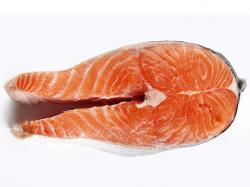Why Is Wild Salmon A Deeper Red Than Farmed Salmon?
September 16, 2013 | 1 min to read

It’s 1:30 AM at the New Fulton Fish Market in the Bronx, New York City. As forklifts zip pallets of seafood through ice-packed loading bays, the fishmongers of Lockwood & Winant are selling fresh Pacific King salmon right off the plane from Washington. Further down the large, cold, cavern, Montauk Seafood Co. has Coho salmon straight in from Alaska. These wild-caught fish glow a deep pink, fleshy ingots glistening on ice. Later today, they’ll be carved into sushi gemstones, gingerly set upon rice and seaweed settings at five-star restaurants in Manhattan.
Farm-raised Atlantic salmon is also for sale here, like the fillets and steaks at your average grocery store. Based on price alone, the farm-raised fish is a steal — $3 per pound wholesale versus $10.50 per pound for wild caught. But a side-by-side comparison reveals a distinct difference in color: farmed salmon is light pink — almost orange — and has a flatter shine, without the rich hues of red.
Color may not be the biggest difference. Nick Stockton — friend and fellow science writer, who once worked on an Alaskan salmon boat — says he tries to only eat wild salmon, mostly “to support the fisheries,” but also because it has superior taste and nutritional content. Yet color is such an important indication of quality that farmers will even dye the farm-raised fish red to increase its appeal.
So why is wild salmon a deeper red than farmed salmon?
To read the rest of the story, please go to: Science Line
